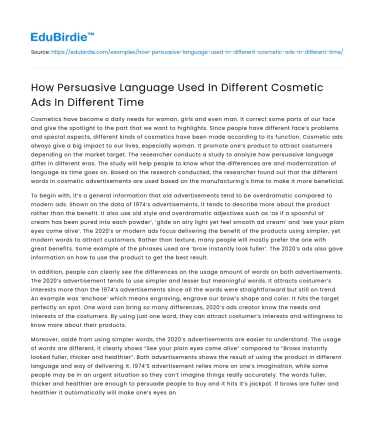Introduction
The cosmetic industry, a sector characterized by its perpetual growth and innovation, has long relied on persuasive language to captivate consumers. The evolution of advertising strategies over time reveals a fascinating interplay between language and societal values. From early 20th-century advertisements emphasizing scientific breakthroughs to contemporary campaigns promoting inclusivity and self-expression, the language used in these ads reflects broader cultural shifts. This essay delves into the evolution of persuasive language in cosmetic advertising, highlighting how different eras have shaped the messages conveyed to consumers. By examining examples from various time periods, this analysis will illustrate the dynamic nature of advertising language and its impact on consumer perception. Understanding these developments not only sheds light on the historical context of advertising but also provides insights into current marketing trends and future directions.
The Early 20th Century: Science and Innovation
In the early 20th century, cosmetic advertisements predominantly focused on scientific advancements and innovation. This era witnessed the burgeoning of industrialization, and advertisers capitalized on the notion of scientific progress to allure customers. For instance, Pond's cold cream ads from the 1920s often emphasized the "scientific formula" that promised unprecedented results. As historian Kathy Peiss notes, "The language of science lent authority to the claims made by advertisers, reassuring consumers of the efficacy and safety of their products" (Peiss, 1998). The use of terms like "formula," "scientifically tested," and "clinical trials" served to instill confidence in consumers, positioning cosmetics as modern marvels rather than mere luxury items.
Save your time!
We can take care of your essay
- Proper editing and formatting
- Free revision, title page, and bibliography
- Flexible prices and money-back guarantee
Furthermore, the language employed in these ads often drew from the burgeoning field of psychology. Advertisers exploited the emerging understanding of human behavior to craft messages that resonated deeply with consumers' desires and fears. A common tactic was to appeal to the fear of aging or social exclusion, suggesting that the use of certain products could stave off these undesirable outcomes. This strategic use of persuasive language not only increased product sales but also helped establish long-lasting brand loyalty. However, it is important to acknowledge the ethical implications of such tactics, as they often relied on exploiting consumer insecurities.
Mid to Late 20th Century: Glamour and Aspirational Messaging
The mid to late 20th century marked a significant shift in cosmetic advertising, with a pronounced focus on glamour and aspirational messaging. Advertisements during this period frequently featured glamorous celebrities and models, leveraging their allure to create an aspirational image for consumers. As Vicki Howard highlights, "The allure of celebrity became a powerful tool for advertisers, who used it to associate their products with the glamour and prestige of Hollywood" (Howard, 2003). Terms such as "luxurious," "sophisticated," and "elegant" permeated the language of cosmetic ads, enticing consumers to emulate their favorite stars.
This era also saw the rise of television as a dominant advertising medium, allowing for more dynamic and visually engaging campaigns. The persuasive language in these ads often played on the idea of transformation, promising consumers that they could achieve a glamorous makeover with the use of particular products. A notable example is the iconic "Because You're Worth It" campaign by L'Oréal, launched in 1973. This slogan not only emphasized the product's quality but also tapped into the growing cultural emphasis on self-worth and empowerment. Despite criticisms of promoting unrealistic beauty standards, such language resonated with consumers, reinforcing the aspirational allure of cosmetics.
Contemporary Era: Inclusivity and Authenticity
In recent years, the cosmetic industry has embraced a more inclusive and authentic approach to advertising. This shift is a response to changing societal attitudes towards beauty and identity, with consumers increasingly demanding diversity and representation. Contemporary ads often employ language that celebrates individuality and self-expression, promoting the idea that beauty comes in all forms. Fenty Beauty's groundbreaking campaign in 2017, which introduced a diverse range of foundation shades, set a new standard for inclusivity in the industry. The campaign's language emphasized "beauty for all," resonating with consumers who felt marginalized by traditional beauty standards.
Moreover, the rise of social media has democratized the way cosmetic brands communicate with their audience. Influencers and user-generated content play a crucial role in shaping brand narratives, often prioritizing authenticity over polished perfection. The language used in these campaigns tends to be more conversational and relatable, fostering a sense of community and connection among consumers. However, while this shift towards inclusivity and authenticity is commendable, some critics argue that it can sometimes be superficial, serving as a marketing ploy rather than a genuine commitment to diversity. Nonetheless, the persuasive language of today's cosmetic ads reflects a broader cultural movement towards acceptance and empowerment.
Conclusion
The evolution of persuasive language in cosmetic advertising over the decades illustrates the industry's adaptability to societal changes and consumer expectations. From the scientific allure of early 20th-century ads to the aspirational glamour of the mid-century, and now the inclusivity of contemporary campaigns, the language used in these advertisements mirrors broader cultural trends. Although some tactics have been criticized for exploiting consumer insecurities or promoting unrealistic standards, the industry's ongoing shift towards authenticity and inclusivity signals a more positive direction. As the cosmetic industry continues to evolve, it is crucial for advertisers to remain attuned to societal values and consumer demands, ensuring that their messages resonate meaningfully with their audience. Ultimately, the power of persuasive language lies in its ability to not only sell products but also shape perceptions and contribute to cultural narratives.






 Stuck on your essay?
Stuck on your essay?

